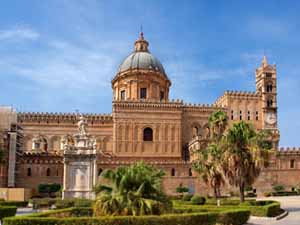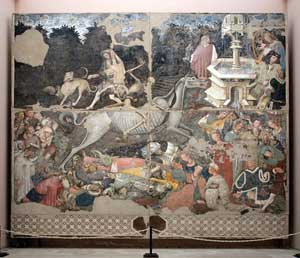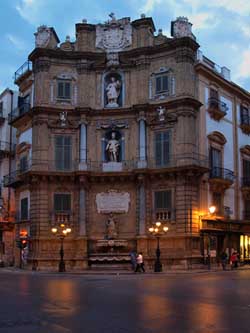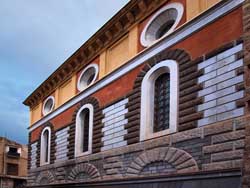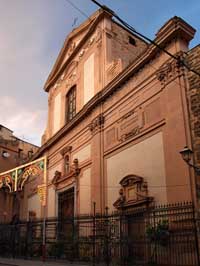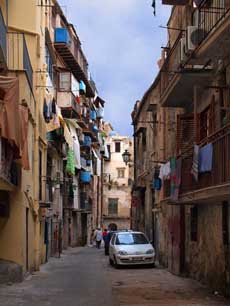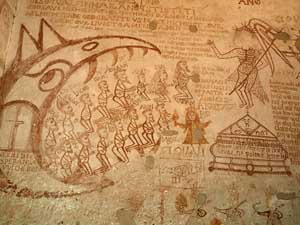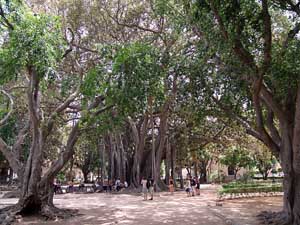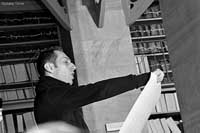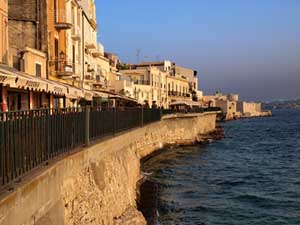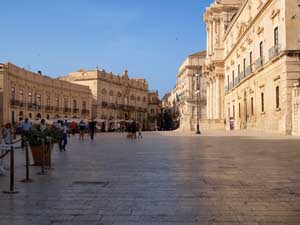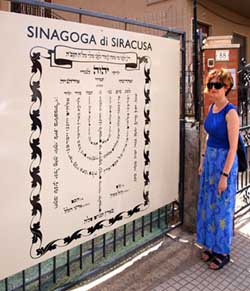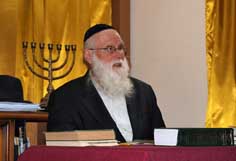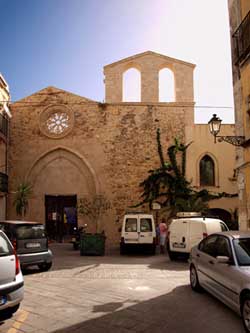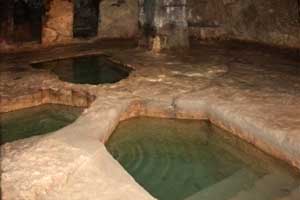
![]()
Welcome • |
About
Us • |
The International Writers Magazine: European History
Rediscovering Jewish Sicily
• Irene Shaland with Bianca Del Bello
Photography by Alexander Shaland
We, with the counsel and advice of prelates and great noblemen of our kingdoms… resolve to order the Jews and Jewesses of our kingdoms to depart and never to return or come back…
(King Ferdinand and Queen Isabella of Spain, “Edict of the Expulsion of the Jews,” March 1492)“The Anousim is a legal category of Jews in halakha who were forced to abandon Judaism against their will, while forcibly converted to another religion." (Medieval Jewish History Resource Directory, 2014)
The Anousim led me to Sicily
Rabbi Barbara Aiello was the first person to tell me about the Anousim or “the forced ones” of the South of Italy: people who are rediscovering their Jewish roots and traditions many centuries after their ancestors were forcefully converted to Christianity. For many, as Rabbi Barbara said, this new knowledge leads to a new identity: formal conversion to Judaism.
I came across Rabbi Barbara’s name while researching the Jewish history of Italy. She is a woman of many “firsts:” first female and first non-Orthodox rabbi to head the first modern liberal synagogue in Italy. She is also the first leader, founder, and the force behind the new Italian Jewish movement, the Anousim. During our phone and online conversations, Rabbi Barbara opened a door for me into the world of little-known Jewish history from the South of Italy: centuries - marked by fear and secrets, decades - filled with the search for one’s identity, courage - to defy conventions and to reinvent oneself, all these were stories of the Anousim. This was how, in my quest for a global Jewish narrative, the islands of Sicily and Sardinia became my next destination. I was drawn to the world that emanated drama, secrecy and defiance, the one I imagined from the Rabbi’s stories. What I discovered in the process was a new understating of history and Jewish identity.
1:Palermo stories: the gateway to understating Sicily and its Jews
The stories of origin
The settlers: The Semitic people were the first group to colonize Sicily and establish a city-port they called Zis, now known as Palermo. They spoke a language similar to Hebrew and developed the first alphabet in the world that had less than thirty characters and was written like Hebrew, from right to left. The year was 800 BC and the people were Phoenicians, great sea traders from the Persian Gulf who settled many Mediterranean islands and established coastal cities. The Greeks came 100 years later; 500 years after the Greeks, the Romans arrived; 500 years after the Romans, the Vandals, then the Arabs, the Normans, the Schwabians, the French, and the Spanish. The last wave of invaders came after the unification of Italy in 1861. These were the “northern-Italians,” as the locals call them.
The name: In the aftermath of the Maccabes’ rebellion against the Seleucid Greeks in the second century BC, Jewish scouting parties sailed from Judea in search of military alliances to assist them in their fight against their enemies. When the Jews approached the beautiful southern coastline of the Mediterranean, they supposedly exclaimed in admiration: “Aiee tal ya” or the “coast of God’s dew.” And this is how we have “Italia.” No historical documents support this legend, but no evidence contradicts it either. And it makes for a good Jewish story, one of my most favorite that I heard from Rabbi Barbara.My dear Palermian friend, Bianca Del Bello smiled when I told her that armed with the knowledge of these origin legends, we were ready for Sicily. Bianca is a beautiful Siciliana and European intellectual. A tour guide par excellence, she speaks several languages and is equally at home in any historical period of her ancient home city, Palermo. Only Bianca could turn five hours of sightseeing into an extensive experience of living and learning by traveling through three thousand years of Sicilian history.
From Bianca we learned that though Sicily (with its capital Palermo) geographically and administratively is indeed part of Italy, the Sicilians, culturally and linguistically, are not Italians. “We are the people of the most conquered island in the world, where one wave of invaders just changed another,” said Bianca, “and so, we created and inhabited our own universe, where the past – Phoenician, Greek, Roman, Byzantine, Jewish, Arabic, Norman, French, Spanish - was never rejected, but accepted and embraced.” The first logical stop to understand this unique world, she told us, was the Palermo Cathedral.
Palermo Cathedral embraced the best of all architectural styles of medieval Sicily, Romanesque, Arab, Norman, and Byzantine. The Cathedral’s immense eclectic structure is arguably the world’s most architecturally diverse building. As we circled it, we pondered the meaning of “multiculturalism” and “inclusion,” if these modern terms could be applied to an ancient place of warship. In architectural terms – certainly! The original church was built in the early medieval period on the site of a pagan temple, and many Punic or Phoenician ruins were still visible.
Photo: Palermo Cathedral embraced the best of all architectural styles of medieval Sicily, Romanesque, Arab, Norman, and ByzantineRecently, the remains of a Roman temple have been excavated behind the Cathedral. Invading Saracen Arabs described this structure as an “infidel” building in 831 AD. It was of course converted into a mosque or the Great Mosque as it was called, and in a typical Sicilian fashion, no major structural changes were made. Then, in 1072, the Normans conquered the island, and the mosque was promptly reconsecrated as a Christian place of worship. By 1130, when Norman Count Roger was crowned as Roger I in this cathedral, the building probably still looked much like the mosque. Though the king was Christian, in the city, called either by its Greek name Panormus (Palermo) or the by its Arabic name “Bal’harm,” Muslims, Jews, and Christians – all enjoyed freedom of worship. The laws were published in several languages, including Hebrew, and on the streets one could hear Norman, Lombard, Greek, Arabic, Hebrew, and Sicilian speech as an amalgamation of them all. We saw an 11th century funeral stone with inscriptions in four languages: Arabic, Greek, Hebrew, and Latin.
Under the Normans, Palermo became one of the wealthiest cities in Europe with revenue exceeding that of all of Platagenet (Norman) England. During this period, an architectural miracle happened and a uniquely Sicilian style was born: Norman-Arabic. It embraced the best of all contemporary styles: Romanesque, Arab, Norman, and Byzantine. If other Sicilian cathedrals, for example in Monreale or Cefalu, are considered masterpieces of this style, it is the Palermo Cathedral that demonstrates the features of this style loudly and proudly as just another one of its “multicultural” adaptations.
We slowly absorbed it all: the Byzantine icon of Madonna and Child over the entrance, Moorish ornaments of the bell towers’ double windows, Arabic geometric inlays and stalactites-resembling decorations on the ceiling, the Catalan south porch, the Aragonese coat-of-arms enhancing the middle portal – all these elements taken together were indeed the best introduction to Sicily and Sicilians. For only on this island, a paradise for any art lover, one can see and experience a successful harmonization of multiple diverse influences into a perfect work of art, be that mosaic or architecture, cuisine or gardening, or the country itself and its people. And the Jews of Sicily and of its capital Palermo – until their forced exile from the island in 1492 - were fully integrated into this cosmopolitan, truly multicultural society.The oldest Jewish community in Europe was in Sicily
The records: During my conversations with Rabbi Barbara, she specifically emphasized the fact that contrary to a popular opinion, Sicily's Jewish culture was not imported from Spain but came from Judea in antiquity as part of the Diaspora. Some sources date the arrival of the first Jewish settlers in Sicily to the destruction of Jerusalem’s Second Temple in 70 AD, when Titus brought over 30,000 Jewish slaves to Rome, some of whom were later sent to the island of Sicily. Academics generally agree, though, that the Jewish presence in Italy began long before that: it is recorded that in 161 BC Judah Macabee, seeking military alliances, sent a delegation to the Roman Emperor. The Jews then settled in Trastevere, across the river from the center of Rome. Probably, a few families of Jewish nobility settled in Southern Italy at that time. It is also possible that a sizable Jewish community was established in the south-eastern part of Sicily in Siracusa during the Hellenistic Greek period, long before the Roman conquest of the island in the middle of the third century BC. Encyclopedia Judaica quotes the record of the first known European Jewish poet and rhetorician named Caecilius of Calacte moving to Rome from Sicily in 50 AD, twenty years prior to Titus’ slaves. What all these various records prove is that the Sicilian Jewish community is indeed the oldest in Europe.
The Pope and the Jews: The next known record that mentions the Jews of Sicily dates to 590 AD and states that the Pope Gregory the Great sent a delegation to Palermo to resolve a dispute involving a large number of local Jews. At that time in Palermo, local priests tried to convert the Jews and confiscated one of the synagogues, so the Pope ordered them to return the property to its rightful owners and stop the coercion. Great story for the history of Jewish-Catholic relationship! The story also reveals that in the 6th century CE, Palermian Jews were wealthy enough to become an attractive target for property appropriation and numerous enough to have more than one synagogue.
The Muslim rule: In 632 AD, Islam began to spread and by the end of the 7th century, about 90 percent of the world’s Jews found themselves living in Islamic lands. When the Arabs conquered Sicily in 831, the Jewish community of Palermo was significantly increased due to a large number of Jews coming from Islamic countries. The new rulers required Sicilian Jews to pay special taxes, and wear a distinctive badge, but they were considered the “People of the Book” and respected. At that time, there were flourishing Jewish communities in other Sicilian cities, such as Siracusa, Messina, Taormina, and Mazara among others. The Jews of Palermo conducted lucrative trade between Sicily, North Africa, and Egypt and prospered under Muslim rule. They spoke Arabic in addition to a Sicilian dialect and as historians note, their vernacular Hebrew was closer to Arabic than Yiddish was to German.
The Norman conquest: The Normans arrived in 1070 AD, and though the Jews still had to pay heavy taxes for their religion and wear a badge (a yellow cord required by the Arabs was changed to a small red wheel), the Jews were recognized as citizens and even allowed to hold public office and buy land. During the Norman period, travelers described the beauty of the Palermian synagogues and the wealth of the Jews. Benjamin of Tudela, himself a Jew, estimated that the 11th century Palermian community numbered at least 1,500 families or close to 6,000 to 8,000 people. In addition to being noted merchants, the Jews of Palermo were physicians, money lenders, translators, precious metal workers, and had a virtual monopoly on the silk and dyeing industry.
The Sicilian Jewish community, an integral and vital part of this unique cultural microcosm of their island, was the most important in the Mediterranean. Though the darker times for the Sicilian Jewry began in the 14th century with the establishment of the Aragonese (Spanish) rule, comparing to the Jews of other European countries, or even other regions of Italy, the Sicilian Jews, until the Edict of 1492, experienced little hostility from either Muslims or Christians.
The Triumph of Death at the Palazzo Abatellis Gallery: This 15th century Gothic-Catalan palazzo turned art museum, contains a curious, little-noticed and rarely-discussed evidence of that uniquely Sicilian pre-expulsion attitude toward the Jews. Bianca suggested we go to the Palazzo Abatellis to take a close look at the late gothic-style fresco, called “The Triumph of Death.” The work of an unknown artist is dated around 1440s. The fresco shows Death on a skinny white horse galloping through a beautiful garden, which symbolizes life itself. The grotesque grimacing horse is placed in the center of the composition. Its rider, Death, is shooting deadly arrows at people in the garden. The fresco’s characters represent all social classes, and on the bottom we see the corpses of those already killed: emperors, popes, and bishops.
“The Triumph of Death” with the Jewish figure among the pious spared by Death, Palermo, SicilyOn the right, are the richly-dressed nobles Death seems to target while on the left, are the pious and the poor that are spared. Only two characters in this group are looking directly at the viewer: perhaps these were the patron or sponsor and the artist himself. The fresco’s overall composition and the message were common for the 14th and the 15th centuries. Highly unusual was the depiction of a Jew in the left group of the pious. Just fifty years before the forced expulsion of the Jews from the island, an unknown artist depicted the Jews as deserving to be spared by Death.
The Expulsion: In 1492, striving to maintain Catholic orthodoxy and “purify” their kingdom, the Spanish monarchs Ferdinand and Isabella ordered the forced expulsion or conversion of all Jews in their lands on pain of death. Though the exact estimates are not available, historians suggest that there were probably 52 Jewish communities spread out across Sicily, numbering somewhere between 35,000 to 40,000 people, though some sources estimate the number to be closer to 100,000. Rabbi Barbara believes that about 40 percent of the Sicilian and Calabrian population at the time of the Edict could have been Jews. The infamous Edict of Expulsion brought an end to the flourishing Jewish culture in Sicily and to the highly important role the Jews played in the regional economy. Palermo archives contain period letters from the local governments, who, fearful of the collapse of banking and commerce, pleaded with the Monarchs to change their mind. In Palermo, by some accounts, Jews constituted over 10 percent of the population and their wealth influenced the four-month extension of the expulsion final date, most probably in order to prolong the looting.
Seeking Palermian Jewish voices – after 500 years of silence
Quattro Canti at night. Exquisite baroque of PalermoOn the way to the Jewish Quarter: My friend Bianca was determined to help us find traces of the long-gone Jewish life in her city, “even if we have to travel through layers of concrete and centuries of ignorance,” she said. In reality, to get to the narrow medieval streets of the former Jewish district, we had to travel through the splendor of the Palermian Renaissance and Baroque. We marveled at Piazza Pretoria with its magnificent 16th century fountain originally built for a Tuscan villa: the fountain’s seductive nudes played in the water as we hurried by. We admired exquisite Baroque of the Quattro Canti, where the four corners (quattro canti) are formed by two major avenues, Via Maqueda and Corso Vittorio Emanuele. The piazza is actually octagonal, formed by four buildings with nearly identical facades decorated with fountains and gorgeous female statues representing the four seasons. Frivolity and naked beauty of the 15th and 16th centuries clashes with the severity of the 12th century Arab-Norman structures of the nearby Churches of la Martorana and San Cataldo. After visiting the churches, we found ourselves right in the middle of Palermo’s Judaic legacy:
La Giudecca. Unlike the European ghettos that were locked in from the outside, Sicilian Jews lived in “La Giudecca,” an open city district or a quarter that offered free passage and that was freely chosen by the Jews to be near their fellow co-religionists. We walked the dense network of narrow ancient streets that used to follow the curve of the river Kemonia, now Via Andrea Giardinaccio. The oldest houses in La Giudecca had a peculiar fixture specific to Palermo: the “gheniza” or a groove in the front door where the house owner kept a small roll with a passage from the Torah. The Jewish district most likely extended as far west as Salita dell Ospedale in the L’Albergheria quarter, a probable location of an ancient Jewish hospital. In 2003, Professor Niccolo Bucaria announced his controversial discovery of a 10th century Miqweh, a ritual Jewish bath, under the 15th century Palazzo Marchesi. The Jesuits built their Church of Santa Maria del Gesu or Casa Professa on the site of the Palazzo. This discovery provoked numerous arguments on whether the structure of what was long believed to be a water reservoir pointed to the location of a second synagogue. Perhaps due to these disputes, the Miqweh of Palermo is not as famous or as touristy as the Miqweh of Siracusa.
The City of Palermo Archives building was built in the 19th century on the part of the Great Synagogue’s site.
Among the prominent sons of La Giudecca in Palermo were the celebrated court physician Master Busach, famous translator from Arabic Moses of Palermo, distinguished scholar David Ahitub, and a renowned astronomer Isaac Al’dahav. I repeat their names aloud a few times over to evoke these great ghosts of the past. In 1393, said Bianca, King Martin I issued a decree by which Jews of Palermo, inhabitants of this neighborhood, were appointed as a court of appeals in all legal disputes among Jews in all of Sicily. The importance given by the local government to the Jews of Palermo’s La Giudecca is illustrated by a documented fact: in 1491, just a year before the Edict, the intervention of the Palermian Jews prevented Jewish refugees from Provence to be sold as slaves.
Recently, the City of Palermo installed brown-and-white street signs which, in Palermian multicultural style, show the street name in three languages: Italian, Hebrew, and Arabic. Many streets were named after the inhabitants ‘professions: Via Calderai – for boilermakers, or Via Lamponelli – for lantern-makers. One street sign reads: Vicolo Meschita, the mosque. The Meschita: The Great Synagogue, admired by numerous travelers from all corners of the earth, was the center of the Jewish quarter. “Palermo’s Synagogue is without equal the world over,” wrote one Ovadyah Yare of Bertinoro in 1487. Architectural historians think that the synagogue structure most probably resembled other Norman-Arab buildings of worship of the time: square in shape, Romanesque in style, and with graceful arches and a cupola.
In the 17th century, the church and the monastery of St. Nicolo Tolentino were built on the site of the Great Synagogue of Palermo. In the late 19th century, part of the synagogue’s and the monastery’s ruins were rebuilt as the City Archives. The street nearby is called Via Meschita or the mosque. Was it ignorance that prompted Sicilian Christians to name the synagogue street “the Mosque?” Or was it a historic memory?
photo: St. Nicolo This 17th-century church was built on the site of the Great Synagogue of Palermo
in PalermoThe physical place occupied by the entire La Giudecca since the 10th century used to be the Arab quarter. During the Norman period and centuries after, the Jewish neighborhood was bordered by a Greek quarter and an Arab souk called “Bah’lara,” which survives today as the Ballaro street market. We visited La Giudecca on Wednesday afternoon, when most Palermo markets were closed but Ballaro was open. We went there and enjoyed its smells, colors, noise. The market’s vibrant life served as another poignant reminder of the silenced voices and extinguished lives of the flourishing Jewish community whose ghosts we left behind. From the market, we headed to another medieval neighborhood, La Kalsa, from the Arabic Al-Khalisa, or “the purest.” The formal name of this district is however, Mandamento Tribunali, meaning the “district of courts.” The name is derived from the menacing presence of the infamous Inquisition Courts in Palazzo Steri.
La Giudecca in PalermoPalazzo Steri: graffiti, tears, and auto-da-fe
The building: The imposing 14th-century building was originally constructed as the private residence of the powerful Sicilian lord Manfredi III Chiaramonte. The palatial fortress style of the structure, its curious mixture of Romanesque and the Gothic elements, became known across the Mediterranean as the Chiaramonte Gothic. In the beginning of the 16th century, this palace became the residence of the Aragonese-Spanish viceroys of Sicily. Later it housed the Royal Customs. But the palace owns its infamous place in history between the years 1600-1782, when it served as the tribunal of the Holy Inquisition. The façade shows the grooves left by iron cages used to display the severed heads of the nobles who had rebelled against the Holy Roman Emperor Charles V.
The prisoners: Today, the palace is a museum dedicated to those who suffered within the Steri walls, including the converted or “neofiti” Jews accused of secretly practicing their old faith. According to “Tracing the Tribe: The Jewish Genealogy Blog” and other sources, neofiti Jews were the focus of the 1516 Palermo riot. A generation after the Expulsion, the Palermian new Christians were still identified as Jews, and persecuted as such, denounced to the Inquisition, and often executed.
Detailed drawing depicting 16 figures with Jewish names that identify them as the twelve tribes of Israel, Abraham, Moses, his brother Aron, Adam and Eve, all coming out of the mouth of a giant menacing-looking fish with a big cross on its head. Was that an unfortunate neofiti trying to convince his executors in his supposedly true Christian faith? Palermo, SicilyWe entered the former Inquisition prison and followed Bianca from one claustrophobic cell to another. What we found was an astonishing art gallery: 16th- 18th century graffiti covering the walls almost from top to bottom. This gallery represents a rare glimpse into the prisoners’ torments, inner struggles with their own demons, and attempts to convince the inquisitors of their innocence. While prisoners’ wall drawings are not uncommon, what is unique for the Steri prison is that most of the graffiti are not anonymous but signed, dated, and accompanied by often highly literate descriptions. The artistic skills are very impressive and so is the inmates’ erudition. The 16 cells open to the public take up two floors of the museum. One cell is identified as the place in which a monk, the legendary Diego La Matina, snapped during his torture and killed his inquisitor with his chains. This episode was immortalized by a famous Sicilian writer Leonardo Sciascia in his novella Morte dell'inquisitore. In another cell, we stayed for a long time studying a detailed drawing depicting 16 figures with Jewish names that identify them as the twelve tribes of Israel, Abraham, Moses, his brother Aron, Adam and Eve, all coming out of the mouth of a giant menacing-looking fish (Leviathan?) with a big cross on its head (the Church?) to a possible salvation impersonated by a strange angel with a devil’s tail wearing a Jesus-like crown of thorns on his head. Was that an unfortunate neofiti trying to convince his executors in his supposedly true Christian faith? But it was in a cell empty of graffiti where we could not hold back our tears. “In December 2013,” said Bianca, “in this cell, we had a Hanukah candle-lighting ceremony accompanied by singing of Hebrew liturgy.”
No matter what was done to us, we thought, it appears that we, the Jews, are indeed indestructible, a truly eternal people. Hundreds of years after the forced expulsion and conversions, tortures and executions, our spirit is alive and our voices are heard.
The auto-da-fe in Palermo: Sentencing the accused or auto-da-fe was staged as a combination of a grand public entertainment and a solemn holy day with all shops and offices closed throughout the city. This ceremony took place either on the Cathedral Square or in front of the Palazzo Steri. The entire spectacle was designed to impress and teach the masses. The condemned were burned at the stake on the square near the Steri, now a park called Villa Garibaldi.
We left the museum and proceeded to this peaceful green park to contemplate the Sicilian story of anti-Semitism and persecution. June 6th 2011, explained Bianca, marked the 500-year anniversary of the first mass execution by the Inquisition of “Judaizing” heretics on that very square.
photo: Villa Garibaldi. Courtesy of Bianca Del Bello. The condemned were burned at the stake on the square near the Steri, now this peaceful green park. Palermo, SicilyNadia Zeldes’ study “Auto da Fe in Palermo 1511” published in Revue de L’Histoire des Religions in 2002 is one of the best available in English scholarly articles focusing on the early executions of Palermo’s Bnei Anousim. Since all Inquisition records were destroyed after the institution itself was abolished in Sicily in 1782, Zeldes’ research relies on the descriptions of eyewitnesses and on the Holy Office’s accounting books.
Zeldes writes that in Palermo two platforms were built right below the windows of the Steri palace. One was for the inquisitors and people of the church and another for the accused who were usually seated at different heights according to their crimes, among which “Judaizing” was considered the highest.
“Judaizing” heretics were the neofiti suspected of practicing their old faith. Sicily was the only place outside of Spain and Portugal where, in the late 15th century, a large part of the population had to quickly convert to Christianity and therefore become a subject of suspicion, persecution, and Inquisition. Estimates of how many Sicilian Jews chose to leave the island and how many converted to Christianity remained vary. The number was considered threatening enough, however, to justify decades of persecution of the converts and their descendants. Little is known about the real extent and practices of the crypto-Jews in Palermo outside of what the Inquisition called the “Judaizing.” These “crimes” included adherence to Jewish religious customs, like circumcising their male children; observing Sabbath on Saturday rather than Sunday; and refusing to eat pork. One young woman was thrown in prison and tortured because neighbors denounced her for changing her undergarments on Friday.
Zeldes describes how the Inquisition was established in Palermo to explain at what point a diverse and multicultural society of that great city turned into a place where neighbors were enthusiastically denouncing each other. Though the Spanish Inquisition existed in Sicily since 1487, the Holy Office was known to “find nothing against Sicilians.” In 1510 a new enthusiastic and energetic Inquisitor was appointed who promised informers a fifth of the property of every “heretic” that they helped to uncover. This simple incentive marked the end of the tolerant microcosm of Palermo and produced a sudden spike of arrests and executions.
Palermo: Jewish cultural renaissance of the 21st century
In her article “The Italian Anousim that Nobody Knows” (2009) Rabbi Barbara Aiello, a founder of the Italian Jewish Cultural Center of Calabria, quotes her colleague Professor Vincenzo Villella, who is convinced that researchers of Jewish history often make a “grave error.” They assume that elimination of institutional Judaism meant the end of Judaism itself. Burning synagogues and the neofiti forced Italian Jews to take their traditions into cellars and secret rooms of their homes. The memories and stories were kept alive, even when descendants forgot their exact meaning. And, as Rabbi Barbara writes, the number of those with a “call of blood,” who think they had a Jewish ancestry and want to learn more about it or even embrace their newly-discovered heritage is on the rise throughout Southern Italy.
Jewish Renaissance in Palermo. The conference dedicated to the Jewish history in Sicily took place inside the City Archives in 2014. Professor from the University of Palermo reads the infamous Edict of Expulsion. The 2014 conference dedicated to the Jewish history in Sicily. Palermo, Sicily.
Photo: Courtesy of the Sicilian Institute for Hebrew Studies. Palermo, SicilyIn Sicily, Bianca told me her acquaintance, a French Jew, Evelyn Aouate founded the ISSE (Sicilian Institute for Hebrew Studies) headquartered at the University of Palermo. In September 2014, during the European Jewish Culture Week, said Bianca, the ISSE organized numerous Jewish heritage centered activities, including a Klezmorim concert that took place at the City Archives that stands on the holy ground of the destroyed Great Synagogue. Outside of the official Jewish Culture Week, many events highlighting the Jewish history of Palermo take place throughout the year. One of the most emotional experiences Bianca told us about was a menorah-lighting ceremony inside the Steri prison cells during Hanukkah.
Bianca showed us another manifestation of the new Jewish history awareness in Palermo: the Garden of the Righteous. Surrounded by centuries-old walls, an ancient courtyard of the now non-existing palace was reborn in 2008 as a memorial garden dedicated to those around the world who saved their Jewish neighbors during the Holocaust. The guest of honor during the dedication ceremony was the Mayor of Tel-Aviv. The initiator of the Gardens movement was a writer Gabriel Nissim, who wrote a book about the anousim “Ebrei Invisibli” translated as “The Invisible Jews.” When Nissim created The Gardens of the Righteous Worldwide Committee, the Municipality of Palermo decided to create one in their own city.
Classes on Hebrew, Jewish culture, and art are held all over Palermo. On Bianca‘s initiative, a class called “Interpretation of Genesis from the Jewish Perspective” is offered in 2015 to an enthusiastic audience of tour guides.
In 2011, Rabbi Barbara Aiello officiated a Bar Mitzvah ceremony of Salvo Asher Parrucca, the first Bar Mitzvah in Palermo in 500 years. Mr. Parrucca, the first anousim in Palermo, is studying for his rabbinate.
2. Siracusa: where the Jewish story comes to life
Siracusa the Great
Siracusa is truly a summation of Sicilian splendor, and if there is one city in Sicily that personifies this magnificent island it is Siracusa. This 3,000 year-old city-in-the making combines Greek and Roman civilizations with ancient Jewish culture and baroque masterpieces. Founded in 734 BC by Greeks from Corinth, Siracusa grew quickly to become a city larger than Corinth and Athens, turning into the capital of Magna Crecia. It became an intellectual magnet that attracted the best brain power of the ancient world: from Aeschylus and Pindar of theater and poetry to Archimedes, the genius of mathematics and physics.The Romans invaded Siracusa in 211 BC, killing Archimedes and the city’s splendor along with him. Even though Siracusa remained the capital of Sicily under the Romans, its glory days were gone. When it was taken over by the Saracens Arabs, Siracusa was reduced to a provincial fortified town. Ironically, a 17th century earthquake served as a catalyst for the city’s renewal, and beautiful baroque buildings and squares came into being.
Today, visitors come to Siracusa enticed by its two main attractions: the Ortygia island with its magnificent Duomo Square and a tangled maze of historic alleyways, and the world-renowned Greek and Roman Archeological Park of Neapolis. For Jewish history pilgrims, Siracusa has one of the most charming Jewish quarters in Italy with its recently-discovered Miqwe (Jewish ritual bath), the oldest in Europe. It is also the only city on the island where one can visit the first synagogue and the first Rabbi in modern Sicily since the Edict of Expulsion of 1492. Rav Di Mauro: a nowadays Biblical Moses
The author at the entrance Synagogue of Siracusa, SicilyWe drove for about 30 minutes from the medieval Ortygia into the contemporary city of Siracusa to find Via Italia near the Tribunale Nuovo. The number 88 building had a large sign on its iron gate: “Sinagoga di Siracusa” adorned with a menorah made up of Hebrew words that tell the story of this congregation. We rang the bell and stepped into a small courtyard. The sign on the building read: ”Comunita Ebraica di Siracusa. Affiliata alla Federazione Comunita Ebraiche dei Mediterrano.” The synagogue occupies the ground floor of an apartment building. Rav di Mauro welcomed us inside. He had a warm smile that immediately put us at ease. With his white long beard and deep long gaze, the Rabbi reminded me of the Biblical saints from mosaics in Capella Palatina and Monreale cathedral. After a tour of the delightful one-room synagogue, we sat down with the Rabbi to hear his story. A native of Siracusa, our new friend Stefano di Mauro, MD (Cardiology), PhD (Psychology and Nutrition), was educated in both Italy and the US, and for many decades had his successful medical practice in North Miami Beach, Florida. While still a medical student in Sicily, di Mauro found out that his classmate was secretly seeking to convert to Judaism. Why? Because, the young man explained, he always knew that he was Jewish. “You see,” the Rabbi told us,” for the Sicilian Anousim, this gut feeling, this inescapable ‘I-always-knew’ voice was the main driver. Historical facts did not matter. Evidence did not matter.” The Rabbi spoke from his own experience of searching for his inner spiritual self for as long as he remembered. A friend’s disclosure was followed by Stefano’s mother’s death-bed confession of the family’s Jewish origins concealed for over 500 years. The dying woman told her son how she and other families bound together by the undisclosed knowledge were trying to live in the same neighborhood, making sure their children played and studied together – an undying hope for sustaining the secret blood line. During the many years that followed, Doctor di Mauro continued to practice medicine while studying Judaism at the same time, eventually undergoing a formal Orthodox conversion and completing his rabbinical studies and ordination in both Miami, Florida and Jerusalem.
The Rabbi proudly showed us his framed ordination license. “As a Rabbi and a leader of the congregation, I am not recognized by Rome,” he revealed to us. “Rome always viewed with suspicion whatever was happening here on the island. We were a conquered colony for over 3,000 years. Nothing changed much.” What did change a great deal, however, was the Jewish life in Siracusa.
In 2007, the 68 year-old Dr. di Mauro left his successful practice in Florida and with his young American wife and two little children moved to his home-town, Siracusa. Here, in 2008 he established the first Jewish congregation on the island in over 500 years. Siracusa city administration did not permit the Rabbi to either buy or rent the property for his synagogue on the touristy Ortygia, so di Mauro returned to his old neighborhood in the outskirts of the city. “It is symbolic,” said the Rabbi, never the one to be stopped by any obstacles.
Rav di Mauro, first Rabbi in Sicily after 500 years of expulsion“This is this area where the Jewish traders settled when they arrived with the Greeks in Hellenistic times, long before the medieval La Giudecca was established on the island of Ortygia.” Led by this 21st century Moses-like man, the inspired congregation now counts about 40 people. Holidays might bring international visitors. Purim is becoming especially popular with guests arriving from as far as Australia.
The Rabbi who brought to life the long-suppressed Jewish story of Siracusa, had also revived a long-forgotten celebration tradition of the island, that of a purim katan.Some sources (i.e., “Sicily’s Ancient Jewish Presence,” by Giovanni Frazzetto, Haaretz, Jan. 2013) state that this unique ritual had long been misattributed to the Spanish city of Saragossa, but historians recently recognized that it actually originated in Siracusa. The story tells of a supposedly historic event when during the reign of the Aragonese King Martin I, the Jews of Siracusa were spared a terrible punishment. The Rabbi told us that the Siracusa’s Megillah narrated how for many years, each time the King visited the Giudecca he was greeted by a procession of elders representing the 12 synagogues in town who presented him the Torah as a sign of their submission. Eventually the Jews decided that the Torah should not be made to bow to the King, and only the empty wooden cases would be shown to him. The years went by, and the King never knew that he was shown only empty Torah cases. One year, a converso who sought the King’s favor disclosed this secret to the King who became enraged and vowed to punish all the city’s Jews. It was not the Esther of the traditional Purim story, but the Prophet Elijah himself who saved his people in Siracusa. He revealed the plot in a dream to a guardian of one of the synagogues. This time, the real Torah books were shown to the King and the Jews were saved. And so it happened, that in January 2013, for the first time in more than 500 years, Siracusans listened to their Rabbi read their own Megillah in their new synagogue.
Ebrei di Ritorno (Returning Jews)
“You have to keep in mind,” said the Rabbi, “this island has had a vibrant Jewish life for over two thousand years. Siracusa was thirty percent Jewish before the Edict. Entire villages on the island sometimes were descendants of Jews that preserved their Jewishness in secret. I see my mission as to help these people to recapture the awareness of their roots.” The Rabbi, who is now 75 years old, is not slowing down. In 2012, he helped to organize a two-day conference in Siracusa supported by the Union of Italian Communities, the umbrella association for the Italian Jewish organizations, and by the Shavei Israel, an Israel-based foundation that reaches out to Jewish descendants around the world. In 2015, three of his students will leave Siracusa to continue their rabbinical studies, become ordained, and hopefully return to their home city. The Jews of Siracusa, forgotten for too long, are coming back home. Centuries after the Inquisition sought to burn Judaism at the stake, the new Jewish community along with the secret stories of identity and traditions that were carried from generation to generation came to live again in one of the greatest cities of the Mediterranean - inspired by Siracusa’s own son.
Jewish Ortygia in Siracusa
In the Jewish neighborhood of SiracusaLeaving the synagogue, we traveled to the Ortygia, a beautifully preserved ancient island where a Greek urban framework still remains for almost three millennia. The streets have a “comb teeth” orientation as they emanate from the Greeks’ Sacred Way, now Via Dione, running through the center of the island. The eastern part of Ortygia is called La Giudecca with streets named after those who lived and prospered there for many centuries: Via Giudecca, Vicolo Giudecca I, II, III, and IV. While thinking of the Rabbi’s stories evoking the ghosts of the Jewish past, we walked along these charming narrow vicoli (alleys) crowned with wrought-iron miniature balconies with flower pots. The Jews settled in this eastern side of Ortygia by design: as Rav di Mauro explained, they wanted to symbolically face Jerusalem. Here stood homes of the most populous Jewish community on the island after that of Palermo, and arguably the most ancient. All buildings in Giudecca-shops, schools, bakeries, and private homes-were constructed, according to the ancient Middle Eastern custom, around the courtyard, in the center of which was a palm and an olive or a citrus tree, which some said survived till today. The prosperity of the Siracusa community was well documented by the Roman tax collectors who kept records of noted wealthy Jewish bankers and merchants. In the first century AD, the community was important enough for St. Paul to arrive there in 59 AD and preach Christianity to the Jews of Ortygia. The twelve synagogues of Siracusa located in Giudecca undoubtedly heard many philosophical debates of local and visiting scholars over the centuries. The last well-known Jewish scholar from Sicily was Siracusa’s son Joseph Saragosi, kabbalist and Talmudist, and the founder of the mystic school in Safed.
The Synagogue
While traces of most of the twelve synagogues are lost to history, one location is now well-known. The Church of San Giovanni Battista (John the Baptist) was most probably built on the ruins of the main synagogue, where, as researchers maintain, St. Paul preached to the Siracusans. Archeologists found out that the synagogue, just like other buildings in the Giudecca, was constructed around a large enclosed courtyard, which, after the Jews were exiled and the synagogue ruined, was broken up to create the square Piazza del Precursore.
The synagogue originally had a different orientation than the church into which it was converted: the adaption was hasty and the beautiful Gothic-style entrance now looks off-center. The church was almost destroyed during the earthquake of the 17th century and now has no roof. This site is often used for summer concerts.
The church of San Giovanni Battista (John the Baptist) was most probably built on the ruins of the main synagogueTo the immediate right of the church’s entrance stands the house where Mario Minniti lived. A native of Siracusa, Mario was a painter, a friend, a follower, and perhaps, a lover of the great Caravaggio, who he met while living in Rome. Mario was probably instrumental in helping a fugitive Caravaggio to secure the Santa Lucia Church’s commission in Siracusa. Today, “The Burial of Santa Lucia,” a masterpiece of this eccentric Italian genius is exhibited near the church’s altar. Art lovers and Caravaggio fans may recognize Mario Minniti’s face from the artist’s well-known paintings: the Lute Player in the Hermitage, Russia; Bacchus in the Uffizi Gallery, Florence; and Fortune Teller in the Capitoline Museums of Rome. In addition to Mario’s role in the history of Italian Baroque painting, Caravaggio’s friend unknowingly played an important part in the Jewish history of Siracusa. He “helped” the archeologists to find out about the former location of the entrance to the synagogue: Mario repeatedly complained to city authorities and finally obtained permission to demolish the arch of the neighboring church’s main door, which hung over the alley that runs along his home.
The Miqwe
Leaving Mario’s house and St. John’s Church, we headed to Via Alagona, one of the most picturesque medieval streets in the Giudecca. There in the Alla Giudecca Hotel, we were scheduled to visit a rare site, a treat for any Jewish history pilgrim: an ancient Jewish ritual bath or Miqwe (mikveh, mikvah) that is located 18 meters (59 feet) beneath street level. The Miqwe can be seen only on the guided tour.
Built in the 6th century AD during the Byzantine period in Sicily, this oldest known Miqwe in Europe was completely hidden in the 15th century, blocked and camouflaged by the Jews of Siracusa, when they were forced into exile. In 1987, architects working on the conversion of an old building into a hotel noticed a strange arrangement of the courtyard stones: they discovered that the stones covered the courtyard’s “ceiling” of an underground chamber underneath it.
Photo: Inside the Miqwe Taormina, SicilyThe hotel guide told us that several truckloads of rubbish had to be removed to uncover an ancient limestone staircase leading to a large rectangular room, entirely cut through stone and supported by four pillars. This principal room contains three pools filled with fresh water. Two additional pools are situated in smaller adjacent rooms. Ventilation and light are provided by an opening in the ceiling, now located next to the current access to the stairs. Additional light probably came from many oil lamps discovered by archeologists and displayed in the hotel’s lobby in glass cases. Since Miqwe water has to be “live” or flowing without any human intervention, the archeologists had to make sure they bore deeply into subsoil to reach the ancient water source.
In traditional Judaism, the Miqwe is given the same importance as the synagogue. Jaqueline Alio, a renowned Sicilian historian, commented that in medieval Italy, a new Jewish community would first build their Miqwe, and then collect the funds for a synagogue or a Torah scroll. Ritual bathing or tevilah (full-body immersion) for both women and men is sacred for Judaism and symbolizes purification. Researchers believe that tevilah became an inspiration for baptism in Christianity or for ghusl in Islam, as a shared spiritual renewal ritual for all three Abrahamic religions.
In the last fifty years, other early medieval Miqwe were discovered in Europe, and all of them became museum pieces like in London (2001) or national historic sites like in Cologne (1956). What makes Siracusa Miqwe, the oldest of all known, so different is that since Rabbi di Mauro started the rebirth of Jewish life in his native city, the Miqwe has been used continuously. Rav di Mauro performed 10 conversions so far and even one wedding at the Miqwe. Quoting the Rabbi, this fifteen-hundred-year-old Miqwe is a true living legacy, a testimony to the undying spirit and light of Judaism.
The Anousim: what we learned from the “children of the forced ones” in Sicily
In the contemporary European context of increasing anti-Semitic and anti-Israeli attitudes, Sicily presents a new and unusually optimistic chapter in the history of the Jewish Diaspora. Our own quest in search of Jewish stories on this island has brought our understanding of both Jewish history and Jewish identity to a new level.
The destruction of synagogues and the burning of “Judaizes” five centuries ago failed to extinguish the Jewish spirit. Rabbi Barbara told numerous stories, some from her own family, of traditions, whose meaning was often forgotten, that survived in their homes ‘secret cellars and in people’s hearts. Cooking continued to conform to kosher dietary laws. Family burials were done outside the church with bodies rapped in simple shrouds. Special marriage blessings were recited in a “strange language” at home under a crocheted canopy. Death-bed confessions of Jewish ancestry to the families were common. The Anousim descendants, whose heritage was so cruelly stolen, hidden, and ignored, sustained their history in their flesh and blood. And perhaps it is the call of blood that drives a continuously growing number of “B’nei Anousim” to search for their historical legacy and reclaim it.
Most Anousim have no records to prove their Jewishness, they just know that this is who they are. Traditional Judaism does not recognize their claim. It took over twenty years for Conservative Judaism to pass a resolution recognizing the Anousim and creating a welcoming space for those who want to return to the Jewish people. In the early 1990s, Rabbi Barbara Aiello, the first reformed Rabbi in Italy, became a leader of the Southern Italian B’nei Anousim movement. For over 25 years Rabbi Barbara has been performing numerous conversions, Bar Mitzvahs, and weddings, and organizing educational events for Jews and non-Jews alike. In Sicily and Sardinia, a Jewish cultural and religious renaissance is on the rise, with events centered on Jewish history taking a prominent place in the intellectual environment of the South of Italy.
While writing this article, I came across Steven Spielberg’s speech addressing the audience during the commemoration of the 70th anniversary of Auschwitz liberation. "If you are a Jew today,” said the founder of the Shoah Foundation, “you know that we're once again facing the perennial demons of intolerance. Anti-Semites, radical extremists and religious fanatics that provoke hate crimes — these people want to, all over again, strip you of your past, of your story and of your identity … causing Jews to again leave Europe.” (World Jewry Digest, January 2015). It seems, I thought, that Southern Italy and especially my beloved Sicily, prove to be different, once again trying to recreate the one and future world of acceptance and multiculturalism.
SheElohim yevarach otha – may this be blessed.© Irene Shaland June 2015
To contact the author, please e-mail to editor@globaltravelauthors.com
Website: http://globaltravelauthors.com/
My Jewish Stories of Africa
Irene Shaland
My husband and I have been traveling the world together for over 30 years, ever-attuned to the Jewish story
A Personal Story about Holocaust
• Irene Shaland
The Jews of India by Irene Shaland


